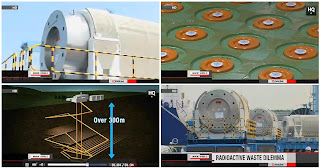What To Do About Nuclear Waste?
 There are questions and then there are questions... What to do about nuclear waste, that will stay dangerously radioactive for tens of thousands of years, is one such question, that neither science nor religion nor anything else seem to provide answers for. Heck, we don't even know what the pyramids in Egypt actually mean. Were they built to tell us something, or just made to impress?
There are questions and then there are questions... What to do about nuclear waste, that will stay dangerously radioactive for tens of thousands of years, is one such question, that neither science nor religion nor anything else seem to provide answers for. Heck, we don't even know what the pyramids in Egypt actually mean. Were they built to tell us something, or just made to impress?Japan has no solution to the big question about nuclear waste. The 54 nuclear plants, that are now mostly idle, were built to provide cheap electricity. No concern about the long-term disposal was OK as long as scientists and government officials agreed to not ask the difficult question: what to do about radioactive waste in an earthquake-prone country.
Now, a report is about to be released that questions that mentality.
NHK World reports:
Japan's national scientists' organization is to propose a radical review
of the government's plan for disposing of highly radioactive nuclear
waste. The group says an initial plan to bury the waste more than 300
meters underground for tens of thousands of years is wrong for the
country.
The Science Council of Japan is to present its proposal next week to the government's Atomic Energy Commission, which decides the country's nuclear policy.
The commission has been asking for advice on reviewing the initial plan, as it became stalled due to opposition from candidate sites.
In a copy of a draft proposal obtained by NHK, the council says the plan has been deadlocked over fundamental issues, as the Fukushima nuclear accident has raised doubts about Japan's nuclear policy.
It says identifying a stable site in Japan to keep the waste for tens of thousands of years is quite difficult, as the country is prone to earthquakes and volcanic activity.
The council says the government should first find temporary storage sites for decades to hundreds of years. It says the government could use the time to develop technology for final disposal, and to build a national consensus on the issue.
An NHK correspondent says the proposal could start public debate as it could be seen as prolonging the disposal problem.
The Science Council of Japan is to present its proposal next week to the government's Atomic Energy Commission, which decides the country's nuclear policy.
The commission has been asking for advice on reviewing the initial plan, as it became stalled due to opposition from candidate sites.
In a copy of a draft proposal obtained by NHK, the council says the plan has been deadlocked over fundamental issues, as the Fukushima nuclear accident has raised doubts about Japan's nuclear policy.
It says identifying a stable site in Japan to keep the waste for tens of thousands of years is quite difficult, as the country is prone to earthquakes and volcanic activity.
The council says the government should first find temporary storage sites for decades to hundreds of years. It says the government could use the time to develop technology for final disposal, and to build a national consensus on the issue.
An NHK correspondent says the proposal could start public debate as it could be seen as prolonging the disposal problem.
NHK World: Scientists to call for review of nuclear disposal
Ahem. Public debate? What does that really mean? No other country has any great ideas about the "disposal problem" except perhaps Finland, that wants to bury it deep underground and then ask future generations to just forget about it. The US has recently rejected a similar proposal, for reasons that I do not quite understand. Everyone else seem to be taking the Japanese approach: Do not ask questions. It is the proverbial elephant in the room. Or the 800-pound gorilla. Or the Mokita, if you happen to live in Papau New Guinea. See, Wikipedia has answers to everything.
Did you know that ocean disposal of nuclear waste was not that uncommon in the past? Most countries have tried it. This method is no longer permitted by a number of international agreements, according to the World Nuclear Association.
Images below from a 1999 IAEA report found here (pdf). According to this report, South Korea dumped some 115 containers with 45 tons of nuclear waste in the Japanese Sea in 1968-1972, while Japan dumped some 3031 containers off its coast in 1955-1969. The list goes on and on: The Netherlands dumped some 28,000 containers in the North Atlantic, and even Sweden thought this was a good idea, dumping some 2895 containers in the North Atlantic back in 1969 and 230 containers in the Baltic Sea in 1959 and 1961. The United States dumped over 34,000 containers of nuclear waste off its Atlantic Ocean coast and over 56,000 containers in the Pacific Ocean. And, don't get me started on the number of disposals by the former Soviet Union in the Japanese Sea, north of Takeshima (also known as Dokdo in Korea...).





Comments